Exclusive: Donald Trump’s pro-police-state acceptance speech must have appealed to many Americans, boosting him in the polls, but another secret to his success may be that he is a 2.0 reboot of Ronald Reagan, says JP Sottile.
By JP Sottile
The conventional wisdom says Donald Trump has turned presidential politics into a reality show. It’s an understandable diagnosis, particularly given his intentionally brassy persona and the professional wrestling-style antics he used to dispatch a motley crew of also-rans on this way to victory. Both were on display in Cleveland where — with the name “Trump” towering over him — the sole survivor triumphantly claimed the ultimate prize at the end of a year-long series
If nothing else, this “reality show as politics” narrative helps pundits make sense of a candidacy they couldn’t predict and the establishment couldn’t control. It affords them the cold comfort of categorizing Trump as something totally new and completely foreign to American politics. But in America’s celebrity-obsessed matrix of infotainment, clickbait-n-switch “news” and the instant iBranding of everything, the more apt description of Trump’s presidential potboiler is not the reality show … it’s the Hollywood reboot.
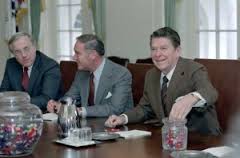
President Ronald Reagan with Secretary of State Alexander Haig and National Security Advisor Richard Allen during a meeting with Interagency Working Committee on Terrorism in the Cabinet Room on Jan. 26, 1981. (Photo from Reagan Library archives)
The “reboot” is the movie industry’s unimaginative answer to an increasingly cutthroat competition for both market share and brand relevance in an ever-more cynical marketplace (which sure sounds like the current political landscape). These 2.0 versions of anything and everything come at a time when the public’s sensibilities are dulled, their views are deeply jaded and their attention is divided by a dizzying array of on-demand options. In response, Hollywood seeks out proven hooks in the hope that garishly repackaged nostalgia will net a bountiful return on their mega-budget investments.
So, instead of banking on a new script or original idea, Hollywood takes a well-worn story and “sexes it up” with more of everything — more explosions, more sex, more twists, more turns, more shock and more schlock. Sometimes this steroidal formula works. Many times it doesn’t. But it worked like a charm in the race for the Republican nomination. Much to the chagrin of “rock-ribbed” Conservatives, Donald Trump captured the GOP’s top spot by rebooting its most successful franchise — the Reagan Revolution.
The “HUUUGE” Reboot
The reboot was as simple as it was effective. Trump took a proven hook — the Reagan Revolution — and “pumped it up” with a relentless tweetstorm of tendentious tropes and a bomb-throwing rhetorical style that would make action-movie filmmaker Michael Bay blush. Like a seasoned — or cynical — Hollywood producer, Trump used political investments in himself, his own companies and those ubiquitous red hats to turn an old franchise into a new smash hit. Like so many of the films that have been rebooted in the whiz-bang era of computer animation, The Donald fills the screen like an action-packed, CGI-enhanced version of The Gipper.
Along the way he’s sexed-up Reagan’s Revolution with a barrage of attacks on the corrupt political system, on the media and on the turncoats in his own party. He’s wowed disillusioned Republicans and entreated embattled Reagan Democrats with explosive charges against China’s economic rapists, with dire warnings about cunning Mexican negotiators and with blanket condemnations of incompetent, perhaps even nefarious politicians.
As in all things, Trump has gone big. He cranked-up the volume on Reagan’s infamous 1980 “State’s Rights” dog whistle delivered by the Gipper at the Neshoba County Fair just outside Philadelphia, Mississippi, where three civil rights workers were murdered in 1964. But Reagan’s racially-tinged signal to economically struggling working-class whites, which some apologists ahistorically write-off as merely a theoretical flourish premised on libertarian principles, was too subtle for Trump.
Instead of blowing a dog-whistle — a nearly silent coded message only those attuned can actually hear — Trump took out a bullhorn to blare an unmistakable message about “rapists” and “bad Mexicans” whose criminal presence was an affront to both America’s traditions and very safety of natural-born Americans in their own homes and communities.
He’s also taken Reagan’s famous refrain that “Government is not the solution to our problem; government is the problem” and updated it for an America corroded not just by special interests and crony capitalism, but also by the idea that government itself is the enemy. Now it’s the politicians populating that government who are the villains. Only an Action Hero-in-Chief can save the voiceless people from treacherous lawmakers. Just so there would be no doubt, he even landed in Cleveland to the theme music from the action-packed Harrison Ford hit “Air Force One.”
More Military Money
And it doesn’t stop there. Trump rebooted Reagan’s “Peace through Strength” mantra with expensive promises to “rebuild” a muscular military that is already far and away the world’s largest, most ubiquitous force. At least Reagan justified his build-up on a three decade-long Cold War against a nuclear-armed adversary. And it followed a post-Vietnam budgetary retreat in military spending. But Trump’s urge to overkill comes when the United States dwarfs the rest of the world in military reach and expenditures. He also plans to “bomb the shit” out of the Islamic State.
But wait, there’s more. Despite his mostly secular life and limited bona fides as a Christian, Trump sold himself to Evangelicals without a hint of Protestant humility. He purposefully sought out Jerry Falwell, Jr. to be the thin edge of his wedge into the Religious Right. It was Falwell the Elder who first marshaled his “Moral Majority” to act as foot-soldiers in Reagan’s Revolution. It was a brilliant end-run around then-President Jimmy Carter’s demonstrable Born Again credentials with Southern voters.
Since then, however, Republican Christians have grown disillusioned with the GOP’s failure to deliver on its promises. So, Trump rebooted the relationship with “the Evangelicals” by simply declaring his “love” for them … and bragging about their support for him. And in true reboot style, he pumped-up the Bible as the only book better than his own.
Of course, Trump’s biggest reboot was lifted directly from Reagan’s winning campaign when he successfully sold the idea of a “crusade to make America great again” at the 1980 GOP Convention. Trump has not only rebooted the line — which first appeared with Reagan’s face on buttons and posters — but he’s actually trademarked it and made it a popular culture mainstay. Sorry, Matt Taibbi. That isn’t “stupid.” That’s how you own it.
In fact, that’s exactly how you reboot it to match the era of human beings as brands. In today’s self-referential, social media-driven world, “owning it” is literally and figuratively the same thing. And because he is “television incarnate” … Trump knew in his bones that there is no such thing as bad publicity in the ratings-starved world of 24/7 cable news.
That’s why his reboot echoes the internet age cry for “MOAR!” – combining more and roar. He’s leveraged more bluster, more shocking headlines and more uncomfortably candid moments into more “free” media than any candidate has ever secured in American history. In the business of politics it’s called “earned media” and Trump played the earned media game like a seasoned pro effortlessly hitting his marks.
The Reagan Pro
And that’s something you might’ve heard a commentator say about Reagan during the 1980 election when skeptics ridiculed and derided him as little more than a “Hollywood actor.” As Frank Rich pointed out in an exhaustive comparison, Reagan faced many of the same criticisms levied against Trump — as a lightweight, as ill-informed and even too dangerous to be near “the button.”
Even Republican National Committee Chair Reince Priebus drew that comparison on the eve of the convention in Cleveland, “… it’s the same thing that happened in 1980 when the bottom fell out of Carter, when people said, Ronald Reagan can be president, I can trust him, and I see him in the White House.”
Once there, Trump — like Reagan before him — will find “the best people” to get the job done. Trump’s daughter Ivanka made that case in her widely-hailed introductory speech. She trumpeted his singular ability to find the right people to do any job. This willingness to delegate was further elaborated in a disconcerting New York Times Magazine story about the eventual selection of Indiana Governor Mike Pence as his running mate. Pence was introduced in the same New York hotel where Reagan announced his Presidential run in 1979.
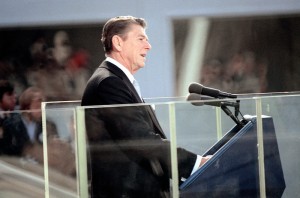
President Ronald Reagan giving his First Inaugural Address in which he declared, “government is the problem.”
But, according to Robert Draper, Trump’s son Donald Jr. first offered the job to former foe and current Ohio Governor John Kasich. Trump the Younger told Kasich he’d be “the most powerful vice president in history.” That’s quite a statement in light of the infamous influence of Dick Cheney or G.H.W. Bush’s underestimated role in Reagan’s Administration.
Draper, quoting an unnamed source inside Kasich’s camp, writes, “When Kasich’s adviser asked how this would be the case, Donald Jr. explained that his father’s vice president would be in charge of domestic and foreign policy. Then what, the adviser asked, would Trump be in charge of? ‘Making America great again’ was the casual reply.”
Coincidentally, Reagan famously said in 1986, “Surround yourself with the best people you can find, delegate authority, and don’t interfere.” That’s because, as Steven Weisman of the New York Times reported in 1981, Reagan governed with “big picture” style that’s been celebrated by his devotees as “visionary” and the true measure of leadership. Meanwhile, critics assailed his notoriously hazy grasp of policy details to no avail. Nothing stuck to the Telfon President. Not even the extra-constitutional mess of Iran-Contra.
Broad Brushstrokes
Now the Teflon Don has rebooted the Telfon President by stripping away the pretense of ideological rigor and campaigning without the restraints of “plans” or “policies.” And like Reagan did when he repeatedly confounded opponents and critics, Trump’s broad brushstrokes somehow defy criticism. His detail-free pronouncements about bringing back jobs that China is already replacing with robots and building a “beautiful” wall that Mexico will gladly fund and administering a religious test at each of America’s international airports are cartoonish. But that’s the point. They illustrate a supersized vision built on the strength of his personal brand.
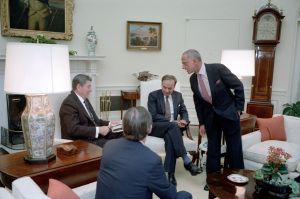
President Reagan meets with publisher Rupert Murdoch and McCarthyite lawyer Roy Cohn in the Oval Office on Jan. 18, 1983. Cohn was also a mentor to the young Donald Trump. (Photo credit: Reagan presidential library)
Trump is not running as a policy wonk. And neither did Reagan. Wonks are weak. Or they are dangerous cogs in the machinery of politics or government. Or they are both, like Barack Obama and Jimmy Carter. On the other hand, big thinkers are strong and their big ideas withstand scrutiny because they are forged in the mint of American Exceptionalism, not foraged out of time-consuming tedium of bookish study.
Ultra-conservative Reaganite Dinesh D’Souza illustrated the “political mystery” of Reagan’s intractable indifference to policy, facts and details by recounting an exchange between then-Secretary of State George Shultz and then-National Security Advisor (and future Iran-Contra conspirator) Robert McFarlane. According to D’Souza’s effusive biography of Reagan, McFarlane remarked to Schultz that the Gipper “knows so little and accomplishes so much.”
That’s exactly the chord Trump and his children strike over and over again like a hit song on Top 40 radio. Forget lyrical details. Think accomplishments. Think of what a big, broad brushstroke painter can do on the canvas of America. He’s already penciling-in a “beautiful” wall around Reagan’s “shining city on hill.” The story of his accomplishments as a builder — dramatically narrated by Academy Award-winner Jon Voight — showed that he’s going to make that city shine like never before.
The Role of a Lifetime
Trump became TV’s biggest reality star by playing the part of America’s ultimate CEO. He’s super-rich, super-entitled and ever-ready to drop a personally branded pink slip on a contestant seeking that ultimate brass ring in post-Crash America — a good job. He became a pop-culture phenom by shouting “You’re fired!” even as CEO incomes swelled and Middle Class Americans wealth evaporated.
Amazingly enough, Reagan also burnished his credentials at the start of his presidency by going on television and saying “You’re Fired!” On Aug. 3, 1981, Reagan publicly “terminated” striking air traffic controllers. That “strong” executive action was a transformative, tone-setting moment for Reagan’s tenure in office and for the nation generally. Is it just blind coincidence that, prior to his turn to politics, Trump is best known for firing people on his smash hit show? Perhaps.
And perhaps it’s just coincidence that Reagan also had a talent for spinning minor celebrity into gold. He punched his golden ticket in the 1950s after years as a nondescript B-Movie actor. He leveraged a role as a chimp’s sidekick into a remunerative gig as a spokesperson and television host for a Cold War-enriched General Electric. But he ran afoul of GE and the “big government” largesse it enjoyed when he criticized the Tennessee Valley Authority.
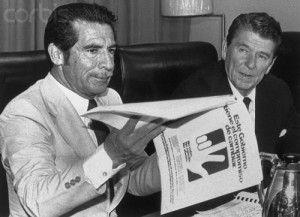
President Ronald Reagan meeting with Guatemalan dictator Efrain Rios Montt, who was later charged with massive human rights including genocide.
By the time he spoke on behalf of Barry Goldwater in 1964, he’d fled the Screen Actors Guild, the Democratic Party and remade himself as a Conservative gadfly. Reagan embodied both the prosperity of the 1950s and the growing reaction to the 1960s. His political evolution into full-fledged Conservative scion played out on the same television screens that made him widely known and wealthy.
When he finally took center stage in the 1980 election, Reagan’s perfectly-coifed, heavily-Brylcreemed pompadour evoked a simpler, more masculine time and a stronger, nostalgic idea of America that stood in stark contrast to Jimmy Carter’s hippy-dippy, professorial weakness. Reagan’s recalcitrant patriotism and his polished delivery of perfectly-crafted one-liners offered a striking image of confidence and success to a nation tired of losing — to Vietnamese Communists, to Soviet hockey teams, to the Japanese auto industry, to Iranian hostage takers, to the new boogeyman of big government and, if you believed defense hawks and military-industrial profiteers, to the erosion of military might that only billions upon billions of dollars could cure.
The Seventies were the age of the working man and the liberated woman — and programs featured a gritty, funny, Norman Lear-driven exploration of working-class America. It was the age of Archie Bunker and Maude, of “Chico and the Man” and “Alice.” By the time the 1970s gave way to Reagan’s America, television, too, wanted winners. The popular culture moved up to penthouses and into mansions, onto yachts and into limos. The daily struggles and social issues of 1970s sitcoms were quickly covered with the gold-plated fantasies of “Dynasty,” “Falcon’s Crest” and, most conspicuously, “Lifestyles of the Rich and Famous.” In the 1980s, the media turned its attention to the movers and shakers and moneymakers. And the sitcoms fled to the suburbs.
This was the gilded backdrop against which Trump played his golden card of a lucky birth into the brass ring of fame as a real estate mogul. The stage was set with unpaid-for tax cuts, deregulation and money artificially pumped into the economy through a spike in defense spending. Today, it’s easy to forget the bubble of Reaganomics. The Crash of 2008 wiped away many things, including the memory of bubbles past.
The fact is that “Morning in America” wasn’t a generational economic boom. It was a momentary, debt-fueled bubble that caused a market crash, a banking crisis and, eventually, a sharp recession. The bubble was inflated and exploded by corporate raiders, leveraged buyouts, massive budgets deficits, and the highly speculative, deregulation-fueled real estate boom of the 1980s.
This was the setting for the self-referential building spree that made Trump the self-appointed poster boy of the go-go 1980s. Like the Ponzi-esque Savings and Loan Scandal that paper-thin recovery spawned, some Trump companies too went bankrupt. And yet he eventually returned to profit, just like the financialized speculators who have bet for and against each successive up and down of the “business cycle” since Reaganomics unleashed the roller coaster. Indeed, Trump’s recurring spikes in wealth and four bankruptcies make him the living embodiment of the perpetual boom-and-bust cycle that came with Reagan’s neoliberal revolution.
Mourning In America
According to the conventional wisdom, Trump’s “dark” and dictatorial speech in Cleveland was a Nixonesque pivot away from hopeful Reaganism. If true, his fearful “law and order” candidacy further inoculates the Reagan legacy from being infected by “Trumpism.” But it doesn’t.
First, the current conventional wisdom belies the truth about Reagan’s underlying appeal to “law and order.” He was widely known as an outspoken “law and order” Governor of California during the upheavals of late 1960s and early 1970s. And it ignores his escalation of the War on Drugs.
Secondly, it fails to properly account for the reality of Reagan’s “sunny optimism,” which was heavily shaded with attacks on bogus “welfare queens,” draconian policies that stoked homelessness among alleged ne’er-do-wells who supposedly slept on steamy street grates “by choice,” and by his troubling comfort with extra-constitutional executive power.
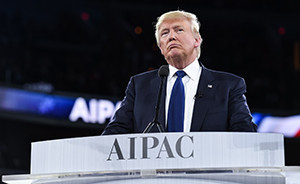
Republican presidential candidate Donald Trump speaking to the AIPAC conference in Washington D.C. on March 21, 2016. (Photo credit: AIPAC)
And, in many ways, “revolutionary” Reagan was himself an accomplished rebooter. He hit Baby Boomer nostalgia at just the time they were leaving disco dance floors and skipping out on the “key parties” of the 1970s to settle down into a black-and-white rerun of “Father Knows Best.” Their nostalgia was stoked by economic uncertainty, a foreign menace and fear of the social disorder from urban decay.
That’s the same ominous triad Trump deployed in Cleveland. Sadly, the deeply-seated problems — governmental malaise, political corruption, the haunting impact of an unnecessary terrible war and intractable economic stagnation — are fueling Trump now, just like they fueled Reagan then.
Of course, loyal Reagan apostles like Peggy Noonan categorically deny the comparison and steadfastly defend the separation between the Church of Ronnie and Trump’s rebooted Republican Party. During NPR’s convention coverage, former Bush adviser and current ABC political analyst Matthew Dowd lamented that the GOP finally transformed into a cult of personality.
But how can anyone say that with a straight face when so many still effusively praise Reagan in spite of Iran-Contra, the Crash of 1987, the Savings and Loan Scandal, massive deficit spending and the dispatching of the mentally ill to America’s streets?
Even mainline Democrats are loathe to make the obvious comparison, in no small part because they love using Reagan’s geniality and comparative “moderation” as a weapon against today’s GOP. “Reagan wouldn’t make it in today’s Republican Party,” they like to say. Maybe that’s because his legacy has been co-opted by the free-trading, welfare-reforming, crime-fighting, Wall Street-deregulating Clinton revolution inside the Democratic Party. Perhaps the biggest plot twist of all is that President Bill Clinton completed much of Reagan’s stalled revolution.
Most importantly, the conventional wisdom about Trump’s “dark reality show” misses the truth about the source of Trump’s troubling reboot. Like many of the blue-collar whites foundering in a fading Middle Class, Trump is a byproduct of Reagan’s ill-fated Revolution and its worst excesses, of its broken promises and stunted dreams.
But, as one of the few who mastered the art of that raw deal, Trump is also strangely qualified to champion the grievances it created. Like so many bad movie reboots, Ronald Reagan not only made Trump’s rise possible, but his revolution helped make Trump into The Donald in the first place. The symmetry is so complete that one might even say it “seems scripted.”
JP Sottile is a freelance journalist, radio co-host, documentary filmmaker and former broadcast news producer in Washington, D.C. He blogs at Newsvandal.com or you can follow him on Twitter, http://twitter/newsvandal.

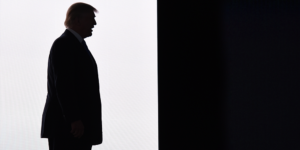
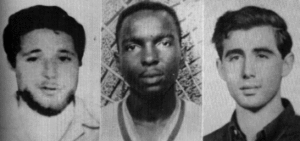
I think that Trump has been using the “show business” model of stimulating public support since well before he announced his candidacy. He has used not only Ronald Reagan as a template but also numerous right wing talk show hosts, who are never afraid of controversy or reluctant to slap down an opponent with salty rhetoric or an unadorned insult. Think Rush Limbaugh, Glenn Beck, Michael Savage, Sean Hannity, Mark Levin and numerous others. They have dominated the airwaves since the Reagan years. They can get away with using terms like “Femi-Nazis” and ridiculing notions like preserving the environment or working towards world peace. They can wrap themselves in the mantle of the Christian religion while personally violating every precept Jesus taught.
Their followers don’t care. It’s tribal. Their followers, the same as the Donald’s followers, are making a last stand defense of white privilege. You know it, I know it, and they know it, though they will never admit it, choosing instead to act the role of persecuted martyrs. It works amazingly well, with charges of racism being turned on their head against what a sane person would see as the common victims. In the world of the American right wing, it is the African Americans, Native Americans, Latinos and immigrants from anywhere else in the world who are the oppressors of white people. They purportedly take our jobs, our neighborhoods and, most importantly, our tax money in the form of opulent social programs. This double think would almost be funny if it weren’t so stunningly sad. I often find myself wondering if I’m not living in a Phillip K. Dick novel.
Trump’s eight-year long indulgence in the Obama “Birtherism” controversy was part of the long con leading up to this election. It got him front and center in the political arena, on TV, in the newspapers and in the blogs, where he got to play the role of a brave and noble conservative American patriot. He’s now a hero, basically a WarCraft field commander to a large swath of modern-day voters.
Normally, it would be easy for a rational person to reflexively vote against him. However, there is the complicating issue of Hillary Clinton. Which would be worse, right wing suppression of constitutional rights for a time or nuclear annihilation by a woman who needs to prove she’s got balls bigger than any man’s? And, lest we forget, there will also be a major influence on events by whatever crazy-azz congress we voters elect. Which of the two executives would be more likely to impose their will on, manipulate or otherwise buck the congress? The outsider or the inveterate insider? Which is more likely to get their full agenda rammed through congress? Which is more likely to “sell out” to the other side, using–what was Bill’s term for it–triangulation? (Which leads me to say: about damn time the congress took back its war-making prerogatives from the imperial presidency no matter which one of these autocrats becomes maximum leader. At least the war to end civilization will have been constitutional.)
I have to say that this same thought (i.e.; Trump is essentially another Reagan) occurred to me after watching John Oliver’s weekly (?) comedy/commentary program where he (much like The Daily Show — from whence he came — used to do) was humorously and truthfully commenting on Trump’s followers equating ‘feelings’ with ‘facts’. Reagan and his followers were all about this same crap. You have to be to cover up & distract from nasty policies.
I think Sottile makes a lot of good points in his argument that Trump is Reagan 2.0. One wonders how long America can live in this quasi-reality…
There’s been a good deal of earnest and thoughtful effort on the part of news commentators to get a handle on Trump. Let me suggest that this effort by Sottile–stimulating, provocative, insightful–sets a high-water mark it will be hard to equal.
Amazing analysis. Remember when Reagan told Gorbachev to put up that wall? SMH. The sheer stupidity on display here is mind-boggling.
To say that people are let down, and confused is an understatement. Take my family for instance. My family is for the most part pretty progressive, and they have all been Bernie supporters. A couple of my grown kids, plus a granddaughter, actually marched and carried signs endorsing Bernie. On one televised Bernie rally my beautiful granddaughter was directly behind Bernie, as he spoke from the lectern. Now that’s all gone by the way side.
My relatives are struggling with the idea of voting for Hillary for the lone reason of preventing a Donald Trump presidency. If ever there were a lessor of the two evils when it comes to voting, this election is a prime example of that illogical mindset. Although, what does one do, when voting to at least get liberal minded judges appointed to the Supreme Court. I personally feel on that subject that even having Hillary appoint liberal judges, that she would in someway appoint the wrong liberal judges. As, you all know I really don’t trust, or have any faith in Hillary’s liberalism, let alone her pick for the Supreme Court.
Trump possibly due to General Michael Flynn’s strategy, has a more reasonable foreign policy, which I think would do the world of good if implemented. Although, on other matters Donald scares the day lights out of me. My one problem is will having a Trump as president lead to race riots, and more brutal police actions?
My one wish, which is a large one, is that there will be enough of Bernie supporters who will now join the Jill Stein campaign, and make Jill a real contender. This is the woman we should all hope and pray for to be our first woman president.
Joe, for an answer to your question about race riots, look at Trumps full page ad that he put out in the ’88(?). This was concerning the ‘central park 5’ and the media circus surrounding it. Trump showed his true colors then. I find it interesting that I have yet to see an article that shines any light on sir donalds past antics. Then there is the fact that after serving 13 years for nothing, then being awarded a judgment, Trump was outraged that they were compensated…”after all, they were at that park for some reason”…which meant, being black, they were there for some nefarious reason. It is also funny that traditional repugs fall all over themselves every time Reagan is mentioned, as if he was our messiah, NOT. I think this is called cognitive dissonance. Yes, many that I know that were Bernie supporters will NOT vote for Killery or Dumph…they are going to vote Stein. If Bernie were straight up, was truly POed about the antics of the DNC and really wanted to go to work for the people who put it on the line for him, he should heed Jill Steins invitation. To vote for either of the other two, as a way of stopping the other only plays into the hands of the criminals…enabling the ‘two party’ scam.
Reagan Reboot 2012
https://www.youtube.com/watch?v=SoCQO90-0zQ
Undead Gipper + spray tan + Brown Spider Monkey pelt
Reagan Reboot 2016
http://iamthedonald.com/assets/zombie-donald-trump-mask-flyer.jpg
A more recent example of the Hollywood phenomenon is Arnold Schwartznegger, even Clint Eastwood – flaccid heroes. Ask pretty much any Californian how much good those two celebrities did for our state.
Wow. The author does the Monster Mash in hobnailed boots over the legacy of St. Ronald Reagan. Yet I doubt if he did any more than scratch the surface of that awful man’s deeds. Worse yet, his linking of Reagan to Trump sounds quite reasonable.
The ugliest part of it all is that Trump is very probably the ‘least-bad’ candidate, horrible as he is.
The rich bastards and neocons have a lot to answer for in arranging this year’s election choices.
And the neo-Liberal, Austerity-oriented Globalist Bankster Hillary Clinton responsible for NAFTA, WTO, Most Favored Nation Status with China, Libya, Ukraine, and Syria had nothing to do with the poor state of the USA?
She has been in Power for the past 25 years. Trump has not implemented one of the above policies.
Don’t get me started with the Fed and the quantitative easing and negative interest rates, mass incarceration of minorities, contstant false flags used to justify a police state. Open borders.
Give some Americans credit for being awake. The same thing is happening in Britain, France, Germany, Belgium, Sweden. Anti Globalists are rising. Don’t shoot the messenger. Read the message.
The article is a false comparison, since Reagan redoubled militarism while Trump, though using similar themes to Reagan, is using them to oppose the militarist consensus. Reagan started the neoliberal free trade sidelining of the rule of law while Trump opposes it. The salient fact is that he is opposing a war criminal and wants to throttle back confrontation while it was only luck that we survived Reagan’s tenure. As the above comment indicates, this whole exercise is just one more episode of establishment misdirection on behalf of their war criminal neoliberal enemy of the people.
True.
Michelle Obama backing her hubby is one thing, but coming out and backing crooked Hillary is another. She did not have to stoop so low.
What is phony Michelle teaching her children and the children of America ?
It is okay to cheat your way to the White House ? “Winning (even by cheating) is all that matters ?” How does Bernie Sanders and his followers feel about that ?
It is not that Michelle really believes Hillary is all human, pure, feminine, trustworthy, WOMAN; she lied for the Party, irrespective. I thought Michelle was better than that. But, then I recall thinking her husband was too.
Hillary & Co. are the epic center of greed, ambition and corruption and Michelle & her husband has been close enough to the real thing to know it better than the people they were lying to.
The Democrats are having a hard time trying to make Hillary “look” trustworthy, human, feminine, mother, grandmother, woman. Why is it necessary if she is the real thing ? What a joke.
Talk about teaching our children by example. What a lot of hogwash America.
Sadly Dems, You chose the wrong woman to make history.
Reagan?How about FDR?The last great American POTUS.The illiberals express horror at such a statement,but I see Trump as our savior from those one isn’t allowed to critique,a restorer of American prosperity,and a flat tire on the wheel of divide and conquer,as this article is.
America First!Yeah,hallelujah!
This is one of the most original, coherent and thought-provoking articles I’ve read in a long time. Kudos to the author for an essay I will re-read and share with friends and colleagues. Refreshing, and well-thought out arguments.
If this election is a referendum about Morality, Bill & Hillary Clinton will lose and Bill & Hillary Clinton will lose badly.
http://www.veteransnewsnow.com/2016/07/26/1008125miller-exposes-corruption-that-even-trump-wont-touch/